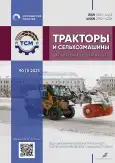К вопросу зависимости прочности зерна кукурузы от его влажности
- Авторы: Погосян В.М.1, Мечкало А.Л.1, Полуэктов А.А.1
-
Учреждения:
- Кубанский государственный аграрный университет им. И.Т. Трубилина
- Выпуск: Том 90, № 1 (2023)
- Страницы: 59-66
- Раздел: Качество, надёжность
- URL: https://journal-vniispk.ru/0321-4443/article/view/132490
- DOI: https://doi.org/10.17816/0321-4443-111809
- ID: 132490
Цитировать
Полный текст
Аннотация
Обоснование. При обмолоте селекционного материала кукурузы влажность имеет основополагающую роль, так как при слишком малой влажности (сухой материал) в процессе обмолота происходит дробление зерновки и посевной материал получается непригодным для использования, а при увеличенной влажности происходит недомолот, а также появляются микродефекты незаметные человеческому глазу, что заметно снижает всхожесть селекционного материала.
Цель исследования. Определить зависимость прочности кукурузного зерна от влажности, произвести эксперимент, выявив усилие достаточное для разрушения семени.
Материалы и методы. В представленной работе проведен анализ научных исследований Г.К. Такоева, М.Г. Голикова и Н.С. Буддо, которые установили зависимости дробления семян во время обмолота початков кукурузы от влажности семени. В настоящей статье представлены данные опытов по изучению прочности зерна кукурузы с различной влажностью при обмолоте на комбайнах Rostselmash NOVA 330 и Claas Мега 370. Данные были получены при помощи осциллографа. Влажность кукурузы оказывает существенное влияние на качество обмолота початков. Представлена схема винтового пресса, который использовался для определения усилия разрушения зерна.
Результаты. Установлено, что с увеличением влажности зерна в початках производительность кукурузных молотилок снижается, что влечет за собой усложнение конструкций молотильных аппаратов. Опыты показали, что при влажности 18,21% зерно кукурузы гибрида Краснодарский 425 МВ выдерживает статическую нагрузку в среднем равную 108 Н, а при влажности 29,28% нагрузка разрушения снижается до 90–100 Н.
Заключение. Проведя анализ полученных экспериментальных данных и, построив соответствующие графики, нами доказано, что при снижении влажности зерна кукурузы с 30 до 17% прочность зерна увеличивается.
Полный текст
Открыть статью на сайте журналаОб авторах
Владимир Макичевич Погосян
Кубанский государственный аграрный университет им. И.Т. Трубилина
Email: pogosyn@gmail.com
ORCID iD: 0000-0001-6248-4029
SPIN-код: 3963-1182
доцент, канд. техн. наук, доцент кафедры «Тракторы, автомобили и техническая механика»
Россия, КраснодарАндрей Леонидович Мечкало
Кубанский государственный аграрный университет им. И.Т. Трубилина
Email: mechkalo.a@edu.kubsau.ru
ORCID iD: 0009-0001-8477-5713
SPIN-код: 8158-0115
канд. техн. наук, доцент кафедры «Тракторы, автомобили и техническая механика»
Россия, КраснодарАлександр Александрович Полуэктов
Кубанский государственный аграрный университет им. И.Т. Трубилина
Автор, ответственный за переписку.
Email: aleksandr.poluektov2000@yandex.ru
ORCID iD: 0000-0001-9082-7199
SPIN-код: 5742-2553
ассистент кафедры «Тракторы, автомобили и техническая механика»
Россия, КраснодарСписок литературы
- Такоев Т.К. Исследование качества работы кукурузных молотилок // Труды Северо-Осетинский СХИ. Т. 17. Орджоникидзе: Северо-Осетинский СХИ, 1956. С. 345–348.
- Голик М.Г. Хранение и обработка початков и зерна кукурузы. М.: Колос, 1968.
- Кравченко B.C. Параметры и режимы обмолота початков кукурузы; дис. ... д-ра техн. наук. Зерноград, 1997.
- Курасов В.С. Механико-технологическое обоснование комплекса технических средств для селекции, сортоиспытания и первичного семеноводства кукурузы; дис. д-ра техн. наук. Краснодар, 2003.
- Погосян В.М. Селекционная кукурузная молотилка // Тракторы и сельхозмашины. 2019. № 5. С. 16–20. doi: 10.31992/0321-4443-2019-5-16-20
- Погосян В.М. Параметры кукурузной селекционной вальцовой молотилки. дис. канд. техн. наук. Краснодар, 2019.
- Матущенко А.Е., Полуэктов А.А., Глазков Д.В. Определение скорости поступательного перемещения початка по вальцам початкоразделителя // Известия Оренбургского государственного аграрного университета. 2021. № 6(92). С. 146–149.
Дополнительные файлы










